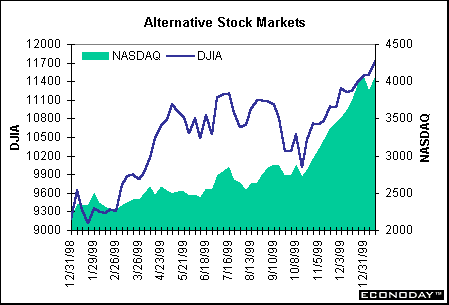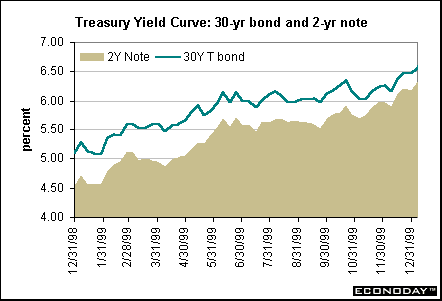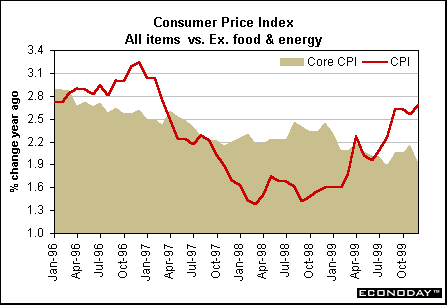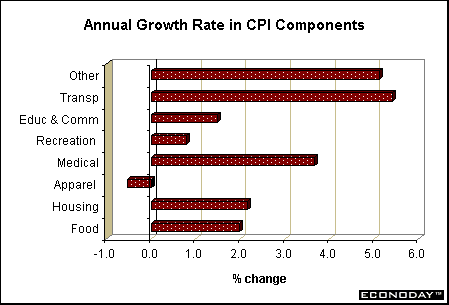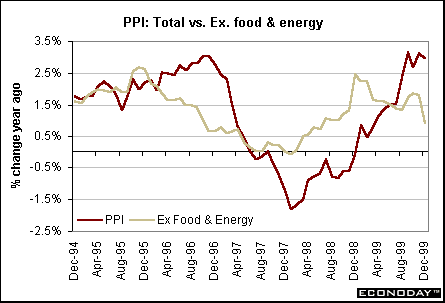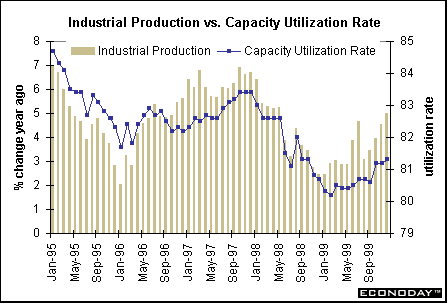| |||||||||||||||||||||||||||||||||||
| Previous Articles |
|
Simply Economics – January 14, 2000 Evelina M. Tainer, Chief Economist, Econoday Inflation news favorable; Greenspan hints of slow hand in tightening Equities soar
The S&P 500 and the Russell 2000 continue to follow the pattern set by the NASDAQ market. The Russell 2000 is so far showing the past gains – and has in fact surpassed its 1999 year-end level. A good portion of the growth in the Russell is coming from technology stocks.
Treasury market still in the doldrums
The U.S. Treasury announced a buyback program that will begin in April. This formalizes the early plans they first discussed last year of buying back "off-the-run" securities in order to reduce their average cost on the national debt. Off the run securities are those that are not as liquid because they might be for odd maturities and therefore are not traded as frequently as current issues. For instance, the yield on a 28-year Treasury bond is probably higher than the yield on the most recent issue of the 30-year bond. Off-the-run issues are often good deals for bond investors who intend to hold the security until it matures. The government will run reverse auctions for the buyback program. Markets at a Glance
(BP = basis points; stock price indices are rounded) Greenspan in the news again Greenspan spent a good deal of the presentation discussing how the economy has benefited by technology in the form of rapid information flows. When he finally touched on the issue of the economy, he noted that although this expansion will soon surpass that of the 1960s in longevity, "there remain few evident signs of geriatric strain that typically presage an imminent economic downturn." Greenspan did note his concern that the soaring stock market was generating a lot of wealth. In turn, gains in wealth were faster than increases in income. This led consumers to increase their expenditures by borrowing and dis-saving. The main problem was that this course of action could soon lead to supply and demand imbalances. He implied that the Fed would like to ensure that forces would put supply and demand back in balance. The financial markets came away with the understanding that the Fed has already gone a long way in addressing these issues so that an aggressive policy would not be necessary. Thus, Greenspan basically confirmed the Fed’s intention to raise rates, but gave the indication that the rate increases on the horizon may be smaller and fewer than those already priced in the market as of January 13. Inflation news is favorable
It is interesting to see where the price increases were in 1999. Not surprisingly, transportation costs gained the most during the year, but this incorporates energy prices. The "other goods and services" category also jumped during the year – but this (small-weighted) category includes tobacco products where prices soared 11.4 percent last year. Among the remaining categories, medical care costs are rising faster than the total CPI; this problem dates back to the 1980s.
The producer price index also showed fairly good news on inflation. The PPI rose 0.3 percent, while the core PPI gained a more moderate 0.2 percent in December. These figures were in line with expectations. The surge in energy prices during the year caused the total PPI to post a year-over-year gain of 3.0 percent. This was the largest annual gain since 1990 and certainly a far cry from the past two years when prices declined! Excluding food and energy prices, the PPI was up a more moderate 0.9 percent in 1999 – less than the previous year, but not as good as 1997 when prices were unchanged.
The bottom-line on inflation? Energy prices led to a spurt in producer and consumer prices in 1999. Fuel and gasoline are important purchases that consumers can’t avoid just because prices are rising. So, we shouldn’t dismiss them out of hand. However, it is important to look at how various prices are shifting in the consumer basket. Both the PPI and the CPI showed that the bulk of consumer and producer goods posted price moderation in 1999. While this doesn’t necessarily mean that the Fed’s worries are for naught, it does indicate that price pressures are generally well contained. The Fed won’t need to pursue the kind of aggressive tightening policy feared by some financial market participants. Cash registers were ringing it in for the holidays
The bottom-line on consumer spending? Total retail sales were more modest on the whole, in the fourth quarter relative to the third quarter. This could help hold down total consumption expenditures when real GDP is compiled for the October to December period. Non-auto retail sales zoomed ahead in the fourth quarter. On the whole, sales were roughly in line with those of the second and third quarters, but slower than year-end 1998 and the first quarter of 1999. Fed officials will worry that the healthy momentum of the fourth quarter could spill into the first quarter. The University of Michigan’s consumer sentiment index did jump to 111.4 in early January for an early reading on consumer optimism. Industrial production ends year on good note The chart below shows how the industrial sector turned around over the course of the year. Many economists are expected production to post solid growth in 2000 as export demand from Europe and Asia spurs domestic manufacturers. The capacity utilization rate, an indicator of resource limitation, was headed higher at year-end, but is far from the 85 percent flash rate that signals impending doom on inflation.
The bottom-line on industrial activity? Manufacturing was relatively weak in the face of booming consumer demand in the past couple of years. That was certainly evident by the heavy bleeding of factory payrolls over the past couple of years. Export demand has turned and this will help U.S. manufacturers going forward. This would be a great concern for the Fed unless consumer demand is curtailed. The Bottom Line Retail sales suggest that consumer momentum was still going gangbusters at year-end. The early reading on consumer optimism showed the state of euphoria continues. This apparently is worrying Fed officials more than the current level of inflation. Indeed, the inflation figures weren’t a source of concern despite higher energy prices. Greenspan continues to worry about a soaring equity market that creates wealthy consumers – and fuels spending. So the cycle begins again. Financial market players are now anticipating a rate hike of 25 basis points for the upcoming FOMC meeting in early February. Looking Ahead: Week of January 17 to January 21 We use the Market News Service survey of forecasts to describe the market consensus. Wednesday Market players are looking for housing starts to edge up 0.6 percent in December to a 1.61 million unit rate. Starts decreased 2.3 percent in November. Higher rates and supply shortages are taking a toll on this sector. Permits are expected to post a 2.0 percent drop to a 1.58 million unit rate. The Beige Book, a compilation of activity described to the Fed banks by businesses in their districts, will be widely anticipated by market participants. The Beige Book will include data through approximately January 10. Thursday Market participants are expecting new jobless claims to decrease 14,000 in the week ended January 15 from last week's 309,000. Claims fluctuate more wildly during the holidays – and the holidays last through Presidents’ Day in February! The international trade deficit on goods and services is expected to remain roughly unchanged in November at $26 billion. This would reflect modest gains in both exports and imports. Financial market participants are looking for an increase in the Philadelphia Fed’s business outlook survey. The Fed index stood at 8.6 in December; a modest rise to 12.0 is expected for January. Friday Economists are predicting that the federal budget will show a surplus of $31 billion for December. This would be an improvement from the year earlier figure. |
|||||||||||||||||||||||||||||||||||||||||||||||||||||||||||||||||||||||||||||||||||||



